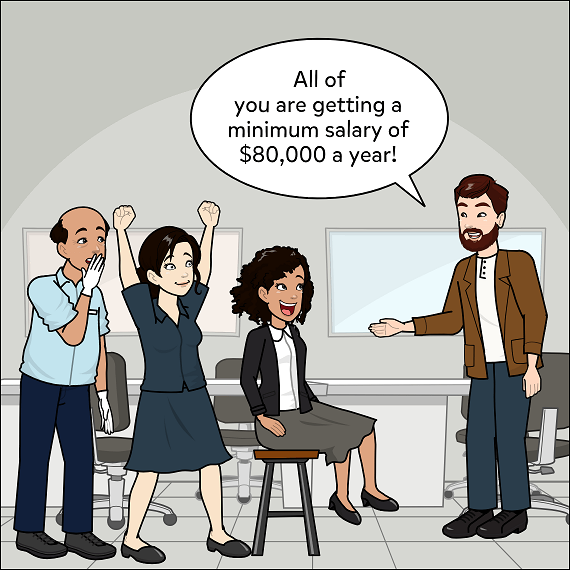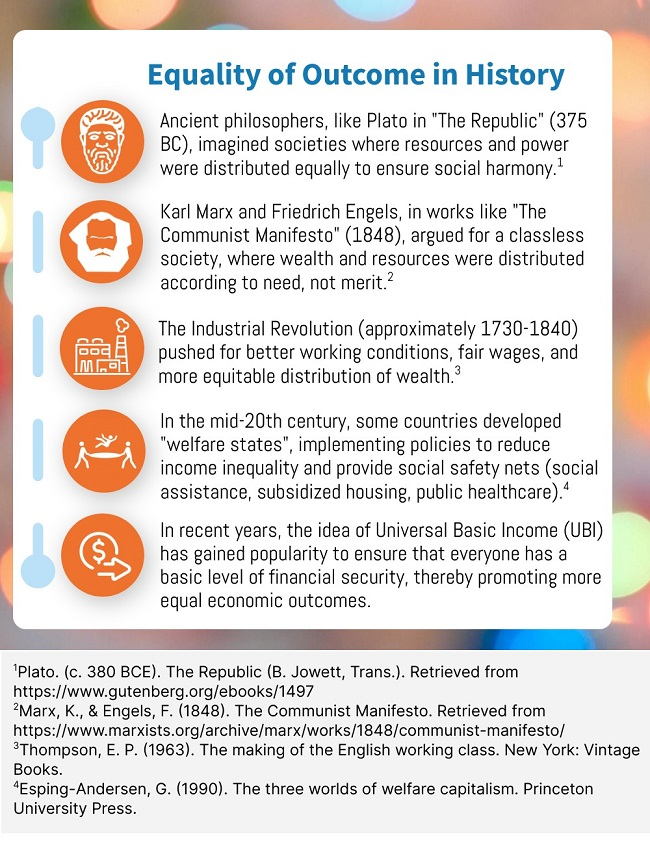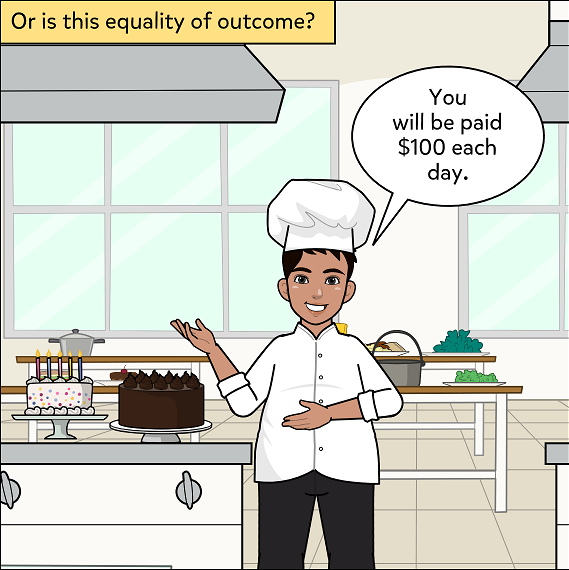
This logo isn't an ad or affiliate link. It's an organization that shares in our mission, and empowered the authors to share their insights in Byte form.
Rumie vets Bytes for compliance with our
Standards.
The organization is responsible for the completeness and reliability of the content.
Learn more
about how Rumie works with partners.
Imagine a scenario where a company owner raises the minimum salary for all employees to $80,000 per year, regardless of their position within the company. This means a janitor would have the same salary as an accountant, or a front salesperson would have the same salary of a sales manager.


Images created by Adeesha Hack via Pixton
What do you think of the company owner's decision to "equalize" his employees’ salaries?
This scenario is an example of "equality of outcome" in the workplace.
Equality of outcome is a form of social and economic justice, especially in terms of resources and opportunities. Its objective is to reduce inconsistency in income, education, healthcare, and other key areas of life.
Did you know?
Some lower-level positions could pay tens of thousands of dollars less than higher-level positions. Compare career advertisements or visit company websites in your country to identify the wage gap among job positions.
Equality of Outcome (EOO) Explained
What does equality of outcome mean?
Questions to consider:
Recall the scenario mentioned at the beginning of this Byte. How would providing a higher income better employees' life?
How could the concept of equality of outcome impact society?
Historical Context of Equality of Outcome
The concept of equality of outcome originated in social and political movements throughout history. It reflects evolving ideas about justice, fairness, and government role in ensuring fairness.
 Image created by Adeesha Hack via Genially. To hear an audio description of the examples in the image above, select the play button on the audio player below:
Image created by Adeesha Hack via Genially. To hear an audio description of the examples in the image above, select the play button on the audio player below:
Equality of Opportunity vs. Equality of Outcome
Equality of outcome focuses on end results. Equality of opportunity, a related concept, focuses on the same starting conditions. The following is the difference between the two concepts in the context of education:
Equality of Opportunity
All people have the opportunity to attend college by completing an application form and paying tuition.
Equality of Outcome
For those who don't have the ability to pay tuition, the government offers scholarships to cover the cost. By offering financial assistance, everyone can attend college.


Images created by Adeesha Hack via Pixton
Scenario: Equality of Opportunity or Equality of Outcome?
During the COVID-19 pandemic, the Canadian Government introduced the Canada Emergency Response Benefit (CERB) to provide financial support to individuals who lost their income due to the pandemic.
The CERB provided $2,000 per month to eligible individuals, including those who were employed but lost their jobs or saw their income significantly reduced. A restaurant worker, bank manager, or professor received the same $2,000 benefit.
Quiz
Is the preceding scenario an example of "equality of opportunity" or "equality of outcome"?
Each worker, no matter the job position or need, received the same amount of monetary benefit. Equality of outcome would have INCREASED benefit to those who needed it the most.
Arguments in Support of Equality of Outcome
One of the main arguments in support of equality of outcome is that it reduces poverty and inequality. By redistributing resources, society can lift people out of poverty and reduce the gap between the rich and the poor. It also corrects historical injustices and systemic inequalities.
With fewer disparities, people are more likely to work together and support one another, instead of competing with each other for resources.
 Image created by Adeesha Hack via Pixton
Image created by Adeesha Hack via Pixton
For these reasons, implementing policies that support equality of outcome can lead to a more cohesive and stable society.
Arguments Against Equality of Outcome
Critics argue that enforcing equality of outcome is costly. This can result in higher taxes to support increased payments to those who need it.
Another argument is if everyone ends up with the same outcome regardless of effort, it might reduce people's motivation to work hard or innovate. This could result in an economic slowdown.
 Image created by Adeesha Hack via Pixton
Image created by Adeesha Hack via Pixton
Finally, some believe that achieving complete equality is often seen as unrealistic and idealistic.
Test Your Knowledge
Which of the following scenarios is an example of equality of outcome?
A. School: Students have one hour to complete a test. How quickly they can read, write, or understand the test is not important.
B. Medical care: Each patient pays $10 each time they visit a family doctor. The level of patient income or illness is not important.
C. Bakery: Bakers are paid $100 a day. Some bakers can produce more cakes than others, but at the end of the day, the salary is the same.
D. City: Some households are lower income and some are higher income. All households receive a $100 bonus to help with expenses.


Image created by Adeesha Hack via Pixton
Quiz
Which of the previous scenarios is an example of equality of outcome?
Equality of outcome focuses on ensuring that everyone ends up with the same result, regardless of the input or effort. In this case, the bakery scenario (C) is the correct answer because it describes a situation where the outcome (salary) is the same for all employees, regardless of their differing roles, responsibilities, and performance levels. This contrasts with equality of opportunity, where everyone has the same chances to succeed but outcomes can vary based on individual efforts and abilities.
Take Action

This Byte has been authored by
Adeesha Hack
Learning Designer
MEd, MA, TESL